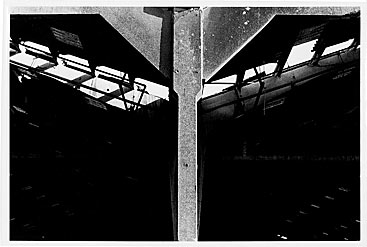
Born in 1940 in New York City, New York (US)
Lives and works in Brussels (BE)

Lille, 1994
Black and white photograph, gelatin-silver print
50 x 60 cm
Year of Purchase: 1998
Since the late 1960s, Peter Downsbrough has been developing an extremely reduced, minimal, plastic vocabulary, basically comprising two tubes or two lines. In this way he is producing an open, many-facetted work – site-specific, scale models, books, postcards and photographs – under the impetus of a single guideline linked to the notion of space.
Since 1977, photography has been for him a medium with which to capture and reveal spaces. It is indissociable from his work on pipes, two tubes with constant spacing, same diameter but different heights, anchored into the ground of some public or private space. Peter Downsbrough’s early photographs reveal this spacing, thereby offering a different frame for the spectator’s view. The photographic work of this artist is urban and political in the original sense of the word, since his chief interest is the life of the city, the architectural features from which it is built up and made. Peter Downsbrough photographs urbanistic complexes, industrial sites, harbour areas and public spaces such as streets and parking lots. Whether it be wasteland, derelict buildings or whatever, these places offer a viewpoint. They let us see the quintessence of our cities. However, it is never a matter of recognizing a location. The subject of the photograph is less important than its structure or its architecture, which thus tends towards a certain universality: ‘To look at my photographs, it could be anywhere.’ Also the human being is not included in this revelation of the city. A Peter Downsbrough photograph is a clue, testifying to the urban reality all around us.
The syntax of his photographs shows a frontal viewpoint, panoramic vision, neutral lighting and firmly outlined forms set in black and white on the paper. Although carefully constructed, the image is never touched up or recentred, being designed directly in the viewfinder. The photograph is strictly architectured, and built up from the line. Whether single or double, whether taking the form of a sticker or a tube, as in the site-specific works, the structuring line has a part to play in the representation as well as in the reality of the place. Line, whether horizontal or vertical, is either suggested or imposed by the photograph’s constituent elements. Evoked through the wet paving stones of the pavement and the city lights in Untitled, Vienna (1980), it splits the photograph into two parts. In Untitled, Gent-Rodenhuize (1994), the horizontal line in the centre of the image rises up into a vertical line that divides the space of the landscape; a natural plant environment then stands in contrast to or alongside the world of industry. As for Untitled, Lille (1994), the line suggested by the post divides the image, imposing a kind of symmetry on it. Finally, Untitled, Aalst (1996) presents a more complex construction. The perspective offered by the lines suggested on the ground by the rail and the absence of paving, then by the edge of the platform and lastly by the metal structure of the canopy, comes up against the rectangle formed by the lorry trailer. Constantly recentred by these converging lines, there is now nowhere else for the eye to escape. Peter Downsbrough’s photographs, consistent with his śuvre as a whole, force us to take a biased, political view of the city. But this rhetoric is served first and foremost by an extremely elaborate technique with nothing being left to chance.
Line Herbert-Arnaud